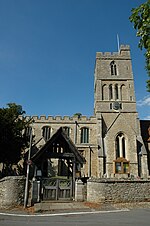Sharnbrook Academy
1975 establishments in EnglandAcademies in the Borough of BedfordEducational institutions established in 1975Secondary schools in the Borough of BedfordSharnbrook ... and 2 more
Training schools in EnglandUse British English from May 2015

Sharnbrook Academy, formerly Sharnbrook Upper School until 2017, is a large, rural academy school located in Sharnbrook, a village in the English county of Bedfordshire. Built in 1975, the school now has over 1900 students and around 300 staff, and includes a large sixth form founded in 1978 of around 650 students.
Excerpt from the Wikipedia article Sharnbrook Academy (License: CC BY-SA 3.0, Authors, Images).Sharnbrook Academy
Odell Road,
Geographical coordinates (GPS) Address External links Nearby Places Show on map
Geographical coordinates (GPS)
| Latitude | Longitude |
|---|---|
| N 52.2232 ° | E -0.5572 ° |
Address
Sharnbrook Upper School
Odell Road
MK44 1JL
England, United Kingdom
Open on Google Maps






